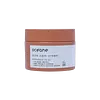What's inside
What's inside
 Key Ingredients
Key Ingredients

 Benefits
Benefits

 Concerns
Concerns

 Ingredients Side-by-side
Ingredients Side-by-side

Water
Skin ConditioningGlycerin
HumectantDimethicone
EmollientNiacinamide
SmoothingCetyl Ethylhexanoate
EmollientSodium Hyaluronate
HumectantPanthenol
Skin ConditioningPearl Extract
AntioxidantSalmon Egg Extract
Honey Extract
HumectantPrunus Persica Fruit Extract
AbrasiveImperata Cylindrica Root Extract
Skin ConditioningSerenoa Serrulata Fruit Extract
Skin ConditioningAdenosine
Skin ConditioningTrehalose
HumectantCetearyl Olivate
Sorbitan Olivate
EmulsifyingAcrylates Crosspolymer
AbsorbentArginine
MaskingPolyacrylate-13
Polyisobutene
Polysorbate 20
EmulsifyingSorbitan Isostearate
EmulsifyingBenzophenone-5
UV AbsorberPhenoxyethanol
PreservativeChlorphenesin
AntimicrobialPropanediol
SolventCaprylyl Glycol
EmollientIllicium Verum Fruit Extract
PerfumingDisodium EDTA
Parfum
MaskingGeraniol
PerfumingButylphenyl Methylpropional
PerfumingLinalool
PerfumingCitronellol
PerfumingLimonene
PerfumingWater, Glycerin, Dimethicone, Niacinamide, Cetyl Ethylhexanoate, Sodium Hyaluronate, Panthenol, Pearl Extract, Salmon Egg Extract, Honey Extract, Prunus Persica Fruit Extract, Imperata Cylindrica Root Extract, Serenoa Serrulata Fruit Extract, Adenosine, Trehalose, Cetearyl Olivate, Sorbitan Olivate, Acrylates Crosspolymer, Arginine, Polyacrylate-13, Polyisobutene, Polysorbate 20, Sorbitan Isostearate, Benzophenone-5, Phenoxyethanol, Chlorphenesin, Propanediol, Caprylyl Glycol, Illicium Verum Fruit Extract, Disodium EDTA, Parfum, Geraniol, Butylphenyl Methylpropional, Linalool, Citronellol, Limonene
Water
Skin ConditioningPropanediol
SolventGlycerin
HumectantCaprylic/Capric Triglyceride
MaskingHydroxyethyl Acrylate/Sodium Acryloyldimethyl Taurate Copolymer
Emulsion StabilisingGlyceryl Stearate
EmollientC12-15 Alkyl Benzoate
AntimicrobialPEG-100 Stearate
Sorbitan Isostearate
EmulsifyingPolysorbate 60
EmulsifyingMelaleuca Alternifolia Leaf Extract
PerfumingAloe Barbadensis Leaf Extract
EmollientHamamelis Virginiana Water
AstringentGlycyrrhiza Glabra Root Extract
BleachingCucumis Sativus Fruit Extract
EmollientCamphor
MaskingSalicylic Acid
MaskingGlycolic Acid
BufferingAllantoin
Skin ConditioningPanthenol
Skin ConditioningSodium Hydroxide
BufferingTocopheryl Acetate
AntioxidantCetearyl Alcohol
EmollientButyrospermum Parkii Butter
Skin ConditioningMagnesium Aluminum Silicate
Absorbent1,2-Hexanediol
Skin ConditioningHydroxyacetophenone
AntioxidantWater, Propanediol, Glycerin, Caprylic/Capric Triglyceride, Hydroxyethyl Acrylate/Sodium Acryloyldimethyl Taurate Copolymer, Glyceryl Stearate, C12-15 Alkyl Benzoate, PEG-100 Stearate, Sorbitan Isostearate, Polysorbate 60, Melaleuca Alternifolia Leaf Extract, Aloe Barbadensis Leaf Extract, Hamamelis Virginiana Water, Glycyrrhiza Glabra Root Extract, Cucumis Sativus Fruit Extract, Camphor, Salicylic Acid, Glycolic Acid, Allantoin, Panthenol, Sodium Hydroxide, Tocopheryl Acetate, Cetearyl Alcohol, Butyrospermum Parkii Butter, Magnesium Aluminum Silicate, 1,2-Hexanediol, Hydroxyacetophenone
 Reviews
Reviews

Ingredients Explained
These ingredients are found in both products.
Ingredients higher up in an ingredient list are typically present in a larger amount.
Glycerin is already naturally found in your skin. It helps moisturize and protect your skin.
A study from 2016 found glycerin to be more effective as a humectant than AHAs and hyaluronic acid.
As a humectant, it helps the skin stay hydrated by pulling moisture to your skin. The low molecular weight of glycerin allows it to pull moisture into the deeper layers of your skin.
Hydrated skin improves your skin barrier; Your skin barrier helps protect against irritants and bacteria.
Glycerin has also been found to have antimicrobial and antiviral properties. Due to these properties, glycerin is often used in wound and burn treatments.
In cosmetics, glycerin is usually derived from plants such as soybean or palm. However, it can also be sourced from animals, such as tallow or animal fat.
This ingredient is organic, colorless, odorless, and non-toxic.
Glycerin is the name for this ingredient in American English. British English uses Glycerol/Glycerine.
Learn more about GlycerinPanthenol is a common ingredient that helps hydrate and soothe the skin. It is found naturally in our skin and hair.
There are two forms of panthenol: D and L.
D-panthenol is also known as dexpanthenol. Most cosmetics use dexpanthenol or a mixture of D and L-panthenol.
Panthenol is famous due to its ability to go deeper into the skin's layers. Using this ingredient has numerous pros (and no cons):
Like hyaluronic acid, panthenol is a humectant. Humectants are able to bind and hold large amounts of water to keep skin hydrated.
This ingredient works well for wound healing. It works by increasing tissue in the wound and helps close open wounds.
Once oxidized, panthenol converts to pantothenic acid. Panthothenic acid is found in all living cells.
This ingredient is also referred to as pro-vitamin B5.
Learn more about PanthenolPropanediol is an all-star ingredient. It softens, hydrates, and smooths the skin.
It’s often used to:
Propanediol is not likely to cause sensitivity and considered safe to use. It is derived from corn or petroleum with a clear color and no scent.
Learn more about PropanediolSorbitan Isostearate is an emulsifer and cleaning agent. It is created from isostearic acid and sorbitol.
As an emulsifier, Sorbitan Isostearate prevents oils and water from separating.
Due to its isostearic acid base, it may not be safe for Malassezia or fungal acne.
Learn more about Sorbitan IsostearateWater. It's the most common cosmetic ingredient of all. You'll usually see it at the top of ingredient lists, meaning that it makes up the largest part of the product.
So why is it so popular? Water most often acts as a solvent - this means that it helps dissolve other ingredients into the formulation.
You'll also recognize water as that liquid we all need to stay alive. If you see this, drink a glass of water. Stay hydrated!
Learn more about Water